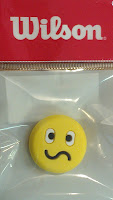Kristianne Bontempo | Towpath Employee | Legit Tennis Fanatic
With the USTA season fast approaching, there are some of us in the market for a new doubles partner or we're wondering if our current doubles partner is right for us. Well we at the tennis desk have taken it upon ourselves to weed out the problem areas and pinpoint the best qualities when searching for a successful, long-term doubles partner.
 |
Bob and Mike Bryan are consistently ranked the #1 doubles
team in the world because of their awesome chemistry.
|
Complements your game
If you're the type of player that likes to hit hard and take risks, you might not want to play with someone who is taking the same risks as you. You need somebody who is steady and consistent so that you can take those risks when the opportunity arises. If you're a steady player, another steady player is a keeper but if you're seeking a powerhouse team, you need a partner with a confident weapon whether that's a serve, strong volleys, or a solid ground stroke.
Complements your personality
You kind of have to like your partner for a chance at a successful long term relationship. If you're a happy go lucky guy playing with somebody who is a bit overly intense, you're not going to have much fun (even if you do play well together). Look at such doubles teams as the Bryan brothers and the top women's duo Vinci/Errani--they didn't climb the ranks by just going though the motions, they actually are good friends who enjoy playing together. So look for somebody you're compatible with on
and off the court.
Equal level
The most successful doubles players are usually the kind that play at the same level. Think about it, if one of you is having an off day, the other won't have to pull too much weight to cover any dips you may be experiencing. You may have a successful stint with a player who is at a different level than you (ie.3.0/4.0) but the stronger player can carry the strain for only so long.
Same goals/mindset
Whether your goal is to smoke your opponents 6-0, play a good game-win/lose, or avoid leaving the court in a body bag, as long as you and your partner are on the same page you're golden.
Trust
Trust can work on so many different levels. Can you trust your partner to show up and be prompt to a match? Can you trust them to hold their serve? Can you trust them not to hit you...we can only hope! But in all seriousness, trust is a vital factor to a successful partnership because lets face it, your partner is covering 50% of the court for you. If it irritates you to give up any control to your partner then maybe singles is better suited for you.
Consistent server
You could be playing with the most powerful server at your club, but if they can't get their serve in 80% of the time then what good are they in the long run? Obviously having a partner with a skilled serve is a bonus, but really as long as it goes in is a good start.
Communicates on the same level
You may like to talk strategy, have a silent understanding, or enjoy chatting about the Cleveland Brown's new recruits. Whatever form you choose, if your partner is in tune with how you like to communicate then you're already on the same wave-length.
Encouragement
There's a difference between encouraging your partner and coaching. Coaching or "giving advice" is tricky since your partner might be easily offended even though you may have the best intentions. Unless they ask for it, your partner most likely isn't open to hearing it. So get that out in the open before you come to a disagreement and leave the coaching to the pros.
Practice together
The most successful doubles teams are the ones that practice together. If you're both serious about improving, and becoming innate on each other's game style and strengths, it is best done during a practice. This is also the time to try out different plays and generally become more comfortable with each other.
If you're unsure of how to approach finding a doubles partner, club tennis pros are great consultants but don't be surprised with their honesty. The best partnerships are the ones that lean on each other's strengths, keep an open communication, win/lose as a team, and just have fun together.
*If you like what you see here, then don't forget to comment or subscribe!*













